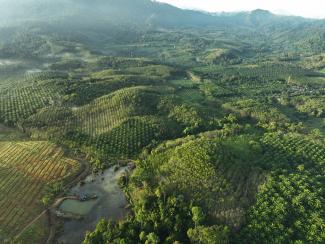Palm oil can be found in foods such as cakes and pastries, creams, ice cream, candy bars, popcorn, chips, frozen French fries, hamburger buns, ready-made pizza dough, margarines, powdered soups, cereals, infant formula and many others. It is also very widely used in the manufacture of cosmetics as an ingredient in body lotions, creams, conditioners shampoos, soaps, bath lotions, lipsticks or face primers. We may not always be aware that a food or cosmetic product contains palm oil, as manufacturers often do not indicate the exact origin of the raw material used and refer to it as 'vegetable oil'. For the sake of our health and the environment, we should limit our consumption and use of palm oil.
The association, which includes organisations from the Czech Republic, Slovakia, Poland, the Netherlands, Portugal, Australia and Indonesia, among others, is campaigning for a reduction in fat consumption and the replacement of palm oil with other healthier oils such as olive oil, sunflower and rapeseed oils. There are also campaigns to encourage food and cosmetics manufacturers to choose palm oil from sustainable crops with controlled environmental impacts. Thanks to the activities of these environmental organisations, consumer awareness of palm oil production has increased significantly.
At the turn of the last few years, the demand for palm oil has been constantly increasing. The reason for this phenomenon is the growing popularity of this oil and its increasing use in the production of not only food, but also cosmetics and biofuels.
Oil from the olive palm (Guinea palm) is very cheap to produce and almost six times more productive than rapeseed oil and up to ten times more productive than soya oil. Unfortunately, despite this high productivity, the ever-increasing demand for palm oil has contributed to the areas under oil palm cultivation being continually expanded. Its main producers are currently Indonesia and Malaysia. Oil palm is grown on huge industrial plantations in rainforest areas and valuable peatlands. Unfortunately, land for oil palm cultivation is acquired by burning and clearing rainforests, which adversely affects the surrounding environment and is a very big ecological threat. The massive devastation of rainforests for oil palm cultivation has a significant impact on accelerating progressive climate change. Indonesia, through the burning and clearing of forests, has become one of the three largest emitters of CO2 in the world.
Crude palm oil, obtained from the flesh of the oil palm, has an intense orange colour due to the presence of significant amounts of carotenoids, a semi-solid, butter-like consistency, and contains saturated fatty acids (mainly C16:0), but also unsaturated fatty acids (C18:1 and C18:2). The second
type of oil extracted from this raw material is oil from the seeds (kernels) of the oil palm, a snow-white solid fat containing mainly saturated fatty acids, which, like coconut fat, belongs to the lauric oil group. Crude palm oil undergoes a refining process to purify the oil, give it the correct organoleptic properties and prolong its shelf life. During this process, almost all nutritionally valuable components such as carotenoids, tocopherols and phytosterols are lost. In addition, refined palm oil can be a source of undesirable substances, i.e. free fatty acids, lipid oxidation products and 3- and 2-monochloropropanediols (3 and 2-MCPD) and glycidyl esters (GE). 3-MCPD is classified by the International Agency for Research on Cancer (IARC) as group 2B 'presumed carcinogenic to humans', for which the Scientific Committee on Food and the European Food Safety Authority (EFSA) in 2018 set a tolerable daily intake (TDI) of 2 μg/kg body weight





